
The Book of Kells is an illuminated manuscript and Celtic Gospel book in Latin, containing the four Gospels of the New Testament together with various prefatory texts and tables. It was created in a Columban monastery in either Ireland or Scotland, and may have had contributions from various Columban institutions from each of these areas. It is believed to have been created c. 800 AD. The text of the Gospels is largely drawn from the Vulgate, although it also includes several passages drawn from the earlier versions of the Bible known as the Vetus Latina. It is regarded as a masterwork of Western calligraphy and the pinnacle of Insular illumination. The manuscript takes its name from the Abbey of Kells, County Meath, which was its home for centuries.

The Book of Durrow is an illuminated manuscript dated to c. 700 that consists of text from the four Gospels gospel books, written in an Irish adaption of Vulgate Latin, and illustrated in the Insular script style.

The Codex Aureus of St. Emmeram is a 9th-century illuminated Gospel Book. It takes its name from Saint Emmeram's Abbey, where it was for most of its history and is lavishly illuminated. The cover of the codex is decorated with gems and relief figures in gold, and can be precisely dated to 870, and is an important example of Carolingian art, as well as one of very few surviving treasure bindings of this date.
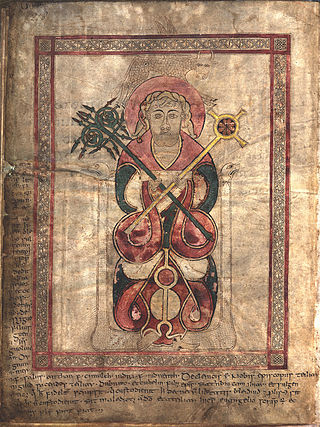
The Lichfield Gospels is an 8th-century Insular Gospel Book housed in Lichfield Cathedral. There are 236 surviving pages, eight of which are illuminated. Another four contain framed text. The pages measure 30.8 cm by 23.5 cm. The manuscript is also important because it includes, as marginalia, some of the earliest known examples of written Old Welsh, dating to the early part of the 8th century. The art historian Peter Lord dates the book at 730, placing it chronologically before the Book of Kells but after the Lindisfarne Gospels.

The Irish Gospels of St. Gall or Codex Sangallensis 51 is an 8th-century Insular Gospel Book, written either in Ireland or by Irish monks in the Abbey of St. Gall in Switzerland, where it is now in the Abbey library of St. Gallen as MS 51. It has 134 folios. Amongst its eleven illustrated pages are a Crucifixion, a Last Judgement, a Chi Rho monogram page, a carpet page, and Evangelist portraits.

British Library, Add MS 40618 is a late 8th century illuminated Irish Gospel Book with 10th century Anglo-Saxon additions. The manuscript contains a portion of the Gospel of Matthew, the majority of the Gospel of Mark and the entirety of the Gospels of Luke and John. There are three surviving Evangelist portraits, one original and two 10th century replacements, along with 10th century decorated initials. It is catalogued as number 40618 in the Additional manuscripts collection at the British Library.

The Codex Beneventanus is an 8th-century illuminated codex containing a Gospel Book. According to a subscription on folio 239 verso, the manuscript was written by a monk named Lupus for one Ato, who was probably Ato, abbot (736–760) of the monastery of San Vincenzo al Volturno, near Benevento. The unusual odd number of Canon Tables suggests these seven folios were prepared as much as two centuries earlier than the rest of the codex.
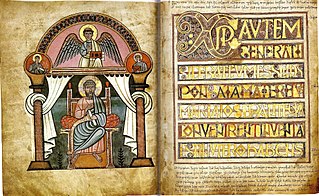
The Stockholm Codex Aureus is a Gospel book written in the mid-eighth century in Southumbria, probably in Canterbury, whose decoration combines Insular and Italian elements. Southumbria produced a number of important illuminated manuscripts during the eighth and early ninth centuries, including the Vespasian Psalter, the Stockholm Codex Aureus, three Mercian prayer books, the Tiberius Bede and the British Library's Royal Bible.
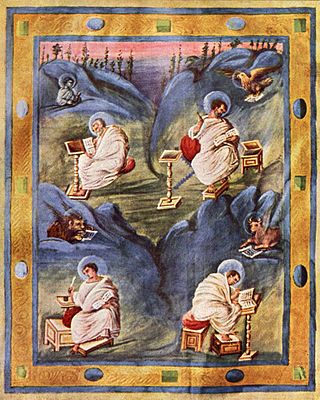
Carolingian art comes from the Frankish Empire in the period of roughly 120 years from about 780 to 900—during the reign of Charlemagne and his immediate heirs—popularly known as the Carolingian Renaissance. The art was produced by and for the court circle and a group of important monasteries under Imperial patronage; survivals from outside this charmed circle show a considerable drop in quality of workmanship and sophistication of design. The art was produced in several centres in what are now France, Germany, Austria, northern Italy and the Low Countries, and received considerable influence, via continental mission centres, from the Insular art of the British Isles, as well as a number of Byzantine artists who appear to have been resident in Carolingian centres.

Ottonian art is a style in pre-romanesque German art, covering also some works from the Low Countries, northern Italy and eastern France. It was named by the art historian Hubert Janitschek after the Ottonian dynasty which ruled Germany and Northern Italy between 919 and 1024 under the kings Henry I, Otto I, Otto II, Otto III and Henry II. With Ottonian architecture, it is a key component of the Ottonian Renaissance. However, the style neither began nor ended to neatly coincide with the rule of the dynasty. It emerged some decades into their rule and persisted past the Ottonian emperors into the reigns of the early Salian dynasty, which lacks an artistic "style label" of its own. In the traditional scheme of art history, Ottonian art follows Carolingian art and precedes Romanesque art, though the transitions at both ends of the period are gradual rather than sudden. Like the former and unlike the latter, it was very largely a style restricted to a few of the small cities of the period, and important monasteries, as well as the court circles of the emperor and his leading vassals.
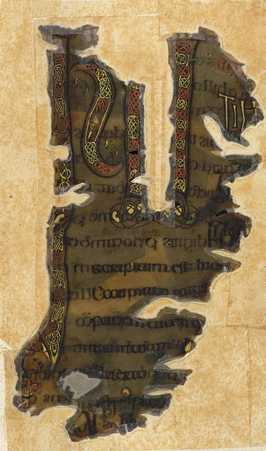
The Otho-Corpus Gospels is a badly damaged and fragmentary 8th century illuminated manuscript. It was part of the Cotton library and was mostly burnt in the 1731 fire at Ashburnham House. The manuscript now survives as charred fragments in the British Library. Thirty six pages of the manuscript were not in the Cotton collection and survived the fire. They are now in the library of Corpus Christi College, Cambridge.

The Schuttern Gospels is an early 9th century illuminated Gospel Book that was produced at Schuttern Abbey in Baden. According to a colophon on folio 206v, the manuscript was written by the deacon Liutharius, at the order of his abbot, Bertricus.

British Library, Egerton MS 609 is a Breton Gospel Book from the late or third quarter of the ninth century. It was created in France, though the exact location is unknown. The large decorative letters which form the beginning of each Gospel are similar to the letters found in Carolingian manuscripts, but the decoration of these letters is closer to that found in insular manuscripts, such as the Book of Kells and the Lindisfarne Gospels. However, the decoration in the Breton Gospel Book is simpler and more geometric in form than that found in the Insular manuscripts. The manuscript contains the Latin text of St Jerome's letter to Pope Damasus, St. Jerome's commentary on Matthew, and the four Gospels, along with prefatory material and canon tables. This manuscript is part of the Egerton Collection in the British Library.

The Vienna Coronation Gospels, also known simply as the Coronation Gospels, is a late 8th century illuminated gospel book produced at the court of Charlemagne in Aachen. It was used by the future emperor at his coronation on Christmas Day 800, when he placed three fingers of his right hand on the first page of the Gospel of Saint John and took his oath. Traditionally, it is considered to be the same manuscript that was found in the tomb of Charlemagne when it was opened in the year 1000 by Emperor Otto III. The Coronation Evangeliar cover was created by Hans von Reutlingen, c. 1500. The Coronation Evangeliar is part of the Imperial Treasury (Schatzkammer) in the Hofburg Palace in Vienna, Austria.
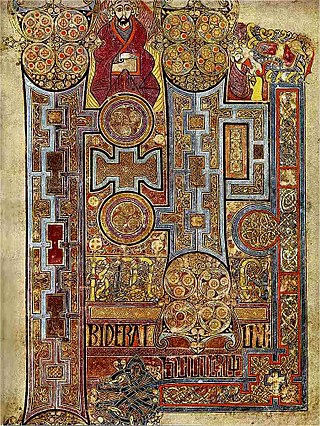
Insular art, also known as Hiberno-Saxon art, was produced in the post-Roman era of Great Britain and Ireland. The term derives from insula, the Latin term for "island"; in this period Britain and Ireland shared a largely common style different from that of the rest of Europe. Art historians usually group Insular art as part of the Migration Period art movement as well as Early Medieval Western art, and it is the combination of these two traditions that gives the style its special character.

The Bible of San Paolo fuori le Mura is a 9th-century illuminated Bible. Of all surviving Carolingian Bibles, it is the most thoroughly illuminated.
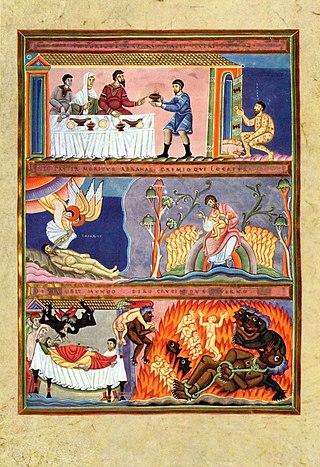
The Codex Aureus of Echternach is an illuminated Gospel Book, created in the approximate period 1030–1050, with a re-used front cover from around the 980s. It is now in the Germanisches Nationalmuseum in Nuremberg.

The Mac Durnan Gospels or Book of Mac Durnan is an illuminated manuscript Gospel book made in Ireland in the 9th or 10th century, a rather late example of Insular art. Unusually, it was in Anglo-Saxon England soon after it was written, and is now in the collection of Lambeth Palace Library in London.

The Lindau Gospels is an illuminated manuscript in the Morgan Library in New York, which is important for its illuminated text, but still more so for its treasure binding, or metalwork covers, which are of different periods. The oldest element of the book is what is now the back cover, which was probably produced in the later 8th century in modern Austria, but in the context of missionary settlements from Britain or Ireland, as the style is that of the Insular art of the British Isles. The upper cover is late Carolingian work of about 880, and the text of the gospel book itself was written and decorated at the Abbey of Saint Gall around the same time, or slightly later.

The Emperor's Bible, also known as Codex Caesareus, Codex Caesareus Upsaliensis or the Goslar Gospels, is an 11th-century illuminated manuscript currently in Uppsala University Library, Sweden. Despite its name, it is not a Bible but a Gospel Book. The book was made in the scriptorium of Echternach Abbey, and is one of four preserved large Gospel Books made there during the 11th century. It was commissioned by Emperor Henry III and donated by him to Goslar Cathedral, where it remained until the Thirty Years' War. It was then lost for about 100 years. Its previous richly decorated cover was also lost at this time at the latest. The book later appeared again in the possession of Swedish diplomat and civil servant Gustaf Celsing the Elder. At the death of his son, it was acquired by Uppsala University.





















